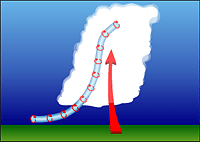What physical
processes are involved in the formation of tornadoes?
In a severe thunderstorm a tornado forms when a mass of warm air meets
a mass of cold air. As
one may have experienced in a poorly insulated house in the middle of
winter, warm air rises and cold air sinks; in the above mentioned
poorly insulated house, it will be warmer near the ceiling while the
floor will be very very cold. This is due to the fact that cold air is
much heavier than warm air. This also applies when a warm air mass
meets a cold air mass; the cold air will begin to sink while the warm
air will rise. As the warm air rises it releases energy into the
atmosphere causing it to cool and fueling the thunderstorm. Warm air
continues to rise to replace the falling cold air, and as it does so
the mass of air will begin to tilt upward into the storm.

http://www.nssl.noaa.gov/edu/safety/tornadoguide.html
The bottom of the air column begins rotating due to a force known as the Coriolis force, a force that is generated in large-scale fluids due to the rotation of the Earth. Meanwhile the area of the rotating column of air begins to shrink, causing it to rotate faster due to conservation of angular momentum. Meanwhile warm air is continues to be pulled up into the vortex that is generated, causing the pressure within the vortex to drop and also contributing to an increase in wind speeds. Eventually the funnel cloud is formed, and when it touches down it becomes what we refer to as a tornado.

http://www.nssl.noaa.gov/edu/safety/tornadoguide.html

http://www.nssl.noaa.gov/edu/safety/tornadoguide.html
The bottom of the air column begins rotating due to a force known as the Coriolis force, a force that is generated in large-scale fluids due to the rotation of the Earth. Meanwhile the area of the rotating column of air begins to shrink, causing it to rotate faster due to conservation of angular momentum. Meanwhile warm air is continues to be pulled up into the vortex that is generated, causing the pressure within the vortex to drop and also contributing to an increase in wind speeds. Eventually the funnel cloud is formed, and when it touches down it becomes what we refer to as a tornado.

http://www.nssl.noaa.gov/edu/safety/tornadoguide.html